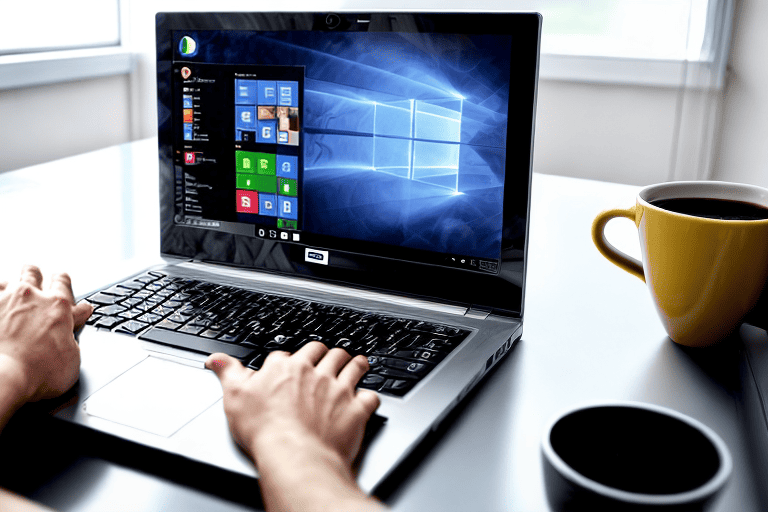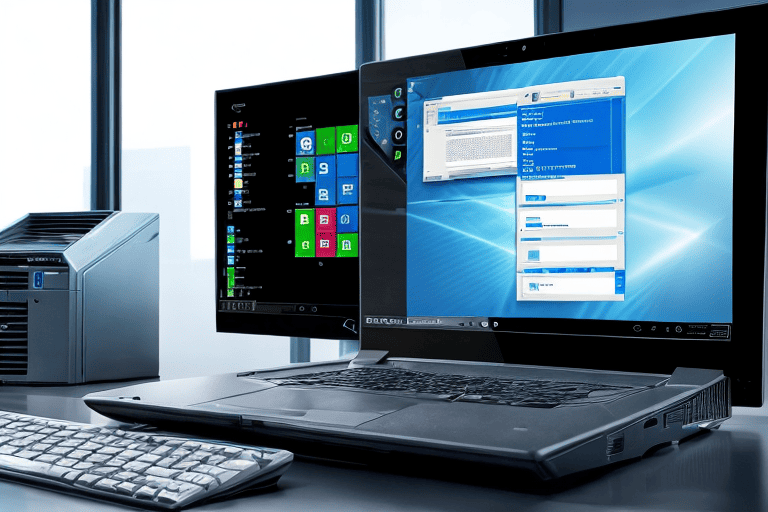
Adjusting the screen brightness on your device not only improves your viewing experience but also helps save battery life. By lowering the brightness to a suitable level, you can significantly extend the time between charges.
Higher brightness settings consume more energy and deplete your battery more quickly.
By reducing the brightness, you can conserve battery power and enjoy longer usage times.
Most devices offer the option to manually adjust the screen brightness or use an automatic setting. Try both options to find the right balance between battery savings and optimal visibility.
In dimly lit environments, consider reducing the screen brightness to the minimum level that allows for comfortable viewing. This not only saves battery but also reduces eye strain.
Click here to learn more about computers, computer repair, and technology
Adjusting Display Brightness Benefits
Enhance your overall user experience. Customizing the screen brightness according to your preference not only optimizes your viewing experience but also helps save battery life and reduces eye strain.
By increasing the brightness, you can enjoy a more vibrant and vivid display, making it perfect for watching movies or viewing colorful images.
Conversely, reducing the brightness creates a dimmer screen, which is ideal for reading in low-light environments or when you want to minimize eye strain.
When it comes to battery life, adjusting the brightness level plays a crucial role in battery optimization. Bright screens consume more power, so lowering the brightness can effectively extend the battery life of your device.
This is especially important for portable devices like smartphones and laptops, where maximizing battery life is often a top priority. Decreasing the brightness level can significantly improve battery life, making it one of the essential battery saving tips for optimal battery optimization.

Changing Display Brightness and Power Consumption
In addition to adjusting the display brightness, there are other methods to conserve power and extend the battery life of your device. Decreasing the screen backlight intensity is a highly effective approach.
By reducing the screen illumination, you can save energy and ensure that your device lasts longer between charges.
Some devices even have power-saving modes that automatically lower the screen luminance when the battery is running low.
This feature can prove invaluable in situations where charger access is limited over an extended period of time. So, if you want to maximize your devices battery life, remember to consider screen dimming as a valuable energy-saving tool.
Supporting Facts about Power Conservation and Battery Life
- Decreasing screen backlight intensity can significantly save energy and extend battery life.
- Some devices have power-saving modes that automatically lower screen luminance when the battery is running low.
- Screen dimming is a valuable energy-saving tool that can maximize your devices battery life.
- Adjusting display brightness is just one of the methods to conserve power and extend battery life.
Recommended Brightness Settings for Battery Saving
Finding the perfect balance between preserving battery life and maintaining a comfortable viewing experience is crucial when it comes to adjusting the display brightness on your device. While reducing the brightness level can significantly decrease power consumption, it’s important to consider the lighting conditions around you.
In we’ll-lit environments, you can comfortably lower the brightness without straining your eyes.
In darker surroundings, increasing the brightness ensures optimal visibility.
For devices with OLED or AMOLED screens, using dark themes or wallpapers can further extend battery life by controlling each pixels brightness. While automatic brightness settings may be convenient, manually adjusting the display brightness level often yields better energy-efficient results.
Adjusting Display Brightness on Different Devices
Adjusting the brightness of your devices display can greatly improve your viewing experience in different environments. Whether you’re using a smartphone, tablet, or computer, finding the right brightness level is essential.
On smartphones and tablets, you can easily adjust the brightness settings through the options menu or quick settings panel.
This allows you to customize your screens brightness to suit your preferences and optimize battery usage.
Speaking of battery life, it’s worth noting that higher brightness settings can drain your devices battery more quickly. By finding the optimal brightness level and utilizing power management techniques, you can extend your devices usage time and reduce the need for frequent charging.
Adjusting the brightness can significantly impact visibility in different lighting conditions. In dimly lit environments, lowering the brightness can reduce eye strain and improve the readability of content.
On the other hand, increasing brightness in we’ll-lit settings ensures clear visibility of the screen. By considering screen brightness settings on different devices, you can enhance your viewing experience and make the most of screen customization options.
| Device | Brightness Adjustment Options | Impact on Battery Life | Visibility in Different Lighting Conditions |
|---|---|---|---|
| Smartphones and Tablets | Easily adjust brightness settings through options menu or quick settings panel | Higher brightness settings can drain battery more quickly | Lowering brightness in dimly lit environments reduces eye strain and improves readability; Increasing brightness in we’ll-lit settings ensures clear visibility |
| computer’s | Adjust brightness settings through display settings or keyboard shortcuts | Higher brightness settings can impact battery life on laptops, but not desktop computer’s | Lowering brightness in dimly lit environments reduces eye strain and improves readability; Increasing brightness in we’ll-lit settings ensures clear visibility |
Ideal Brightness Level for Lighting Conditions
Finding the perfect brightness level for your display is essential for a great viewing experience and to ensure your eyes are comfortable. it’s crucial to adjust the brightness based on the lighting conditions you’re in.
In we’ll-lit environments, like outdoors or brightly lit rooms, increasing the displays brightness can enhance visibility and prevent eye strain.
Conversely, in low-light situations, decreasing the brightness level can reduce eye fatigue and minimize glare.
Adjusting the brightness level is also vital for maximizing battery life. By setting the brightness to a lower level, you can extend your devices battery life, reducing the frequency of charging.
Screen Dimming for Battery Life Extension
When it comes to extending battery life, screen dimming plays a crucial role. By reducing the brightness of your display, you can significantly decrease the energy consumption of your device, resulting in less battery drain.
This is especially beneficial for individuals who heavily rely on their devices throughout the day and want to maximize their battery performance.
Apart from saving power, adjusting the screen brightness also enhances the overall user experience.
Finding a comfortable brightness level reduces eye strain and makes prolonged usage of your device more enjoyable. This feature becomes particularly useful during activities that require extended screen time, like reading or watching videos.
Screen dimming is a versatile feature that can be customized to meet your specific needs. Whether you prefer a slightly dimmed display to create a more relaxed atmosphere or to conserve battery life, this feature allows you to personalize your device.
Benefits of Screen Dimming
- Screen dimming significantly reduces energy consumption, resulting in extended battery life for your device.
- Adjusting the screen brightness enhances the overall user experience by reducing eye strain and making prolonged usage more enjoyable.
- Screen dimming is particularly useful during activities that require extended screen time, such as reading or watching videos.
- Customizable screen dimming allows you to personalize your device based on your specific needs, whether it’s for creating a relaxed atmosphere or conserving battery life.
Screen Settings to Save Battery Power
One crucial screen setting to consider for battery optimization is the utilization of the battery saver or power mode. By enabling this function, your device can automatically modify various settings to conserve battery power when it begins to run low.
Battery saver mode restricts background processes, diminishes display brightness, and reduces performance to prolong battery life.
It is a convenient feature to have when you are without a power source for a prolonged duration or during emergencies when you require your device to endure for an extended period.
Utilizing the battery saver mode can assist in preserving your battery health and guaranteeing sufficient power throughout the day.
Strategies for Managing Screen Timeout to Conserve Battery
When it comes to saving battery life on your device, effectively managing your screen timeout is essential. By adjusting the screen timeout settings, you can extend your battery’s lifespan and reduce the need for frequent charging.
Here are some strategies that can help you efficiently manage your screen timeout:
Optimize the timeout duration: Set a shorter period, like 30 seconds or 1 minute, to automatically turn off the screen when idle, saving battery life.
Utilize adaptive brightness: Enable this feature to adjust the screen brightness based on ambient light conditions, reducing power consumption.
Disable unnecessary notifications: Notifications can drain your battery, so disable any unnecessary ones.
Optimize Screen Brightness for Smartphone Battery Saving
If you’re tired of constantly charging your smartphone and wish there was a way to extend your battery life without compromising on screen brightness, you’re in luck! We will delve into some clever techniques to optimize your screen brightness and save precious battery power. Changing the display brightness is one of the easiest ways to conserve battery life.
By adjusting the brightness level, you can significantly enhance your smartphones battery performance.
Finding the ideal brightness setting can be a challenge. How do you strike the perfect balance between visibility and power consumption when adjusting your power settings?.
Screen Customization Options for Battery Optimization
One essential energy option for battery optimization is the ability to personalize the screen timeout. By setting a shorter timeout period, users can ensure that the display turns off quickly when not in use, conserving battery power.
Some devices provide adaptive brightness settings that automatically adjust the screen brightness based on the surrounding lighting conditions.
This power-saving mode helps maximize battery life by avoiding unnecessary brightness in we’ll-lit environments.
In addition to these customizations, activating battery saver mode further prolongs battery life by reducing screen brightness and limiting background activity. Discovering the optimal balance between power display and comfortable viewing is crucial and may require some experimentation.
Ways to Optimize Battery Life on Mobile Devices
- Personalize the screen timeout: Setting a shorter timeout period conserves battery power by turning off the display quickly when not in use.
- Utilize adaptive brightness settings: Some devices automatically adjust the screen brightness based on surrounding lighting conditions, saving power in we’ll-lit environments.
- Activate battery saver mode: This mode reduces screen brightness and limits background activity, further prolonging battery life.
- Experiment to find the optimal balance: Discovering the perfect balance between power display and comfortable viewing may require some trial and error.
Steps to Speed Up Startup and Boot Times in Windows
How to Use Keyboard Shortcuts to Work More Efficiently
